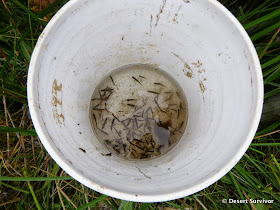As we headed to the site, I couldn't help but notice the numerous bushes with white flowers. It took me a little while to realize that they are white rabbitbrush (Chrysothamnus albidus). It was kind of neat to see something so familiar looking but with a twist.
I also photographed many, many more plants, but will spare you on this post, and get back to the main subject.
My friend Kevin was leading the trip, and when we reached this spring to put in minnow traps, he had to do some deep thinking. Fences have been installed to prevent cattle from falling into the springs, which can be deceptively shallow-looking. Many a cow have taken the plunge, never to exit. The fences are good for keeping the cows out, but they were supposed to be removed for the sampling. Since they weren't, we had to find a work-around.
Installing the traps involved some gymnastics and barbed-wire avoidance skills. Life as a biologist is interesting!
While we were putting in traps, we saw lots of frogs, including Columbia spotted frogs (above) and northern leopard frogs (below).
In the spring, egg mass surveys are done in this area, and it can be really difficult to find any adults. It's neat to see them.
Some of the springs have slurping mud bottoms that feel a little like quicksand (or what I imagine quicksand would feel like, since I've never actually been in real quicksand). I sort of ended up in the mud, because somehow mud and I have a long and complex relationship. Like maybe I still want to be like Desert Girl and jump in mud puddles but now just get sucked into mud holes and muddy caves. It wasn't an entirely unpleasant experience, but it was nice to rinse off later in the day!
After we installed all the minnow traps, it was time for some physical habitat surveys. We divided up into groups, as we not only had UDWR folks, but also people from the US Fish and Wildlife Service, National Park Service, and Southern Nevada Water Authority. We went in different directions. My group's direction took us here:
The water levels are definitely lower in the fall, restricting the fish to the deepest springs. During the spring, after snow melt, the large playa fills with water and is an import migratory stop for birds. In the fall, it makes for fast walking.
After the physical habitat surveys and lunch, it was time to go check the minnow traps. Many were empty, but a few had lots of fish, and not always in places where we thought we'd find a lot.
Every fish was counted and measured before being returned to its spring.
We found speckled dace, Utah chub (on the left, above), and least chub (on the right, above).
It was a good day, and I really enjoyed the company and interesting terrain. Hopefully the least chub will continue to do well in their very specialized habitat.
p.s. You can find out lots more about the Gandy area in Chapter 11 of my book.













Great Summary! Thanks for coming out to help us with our monitoring!
ReplyDelete